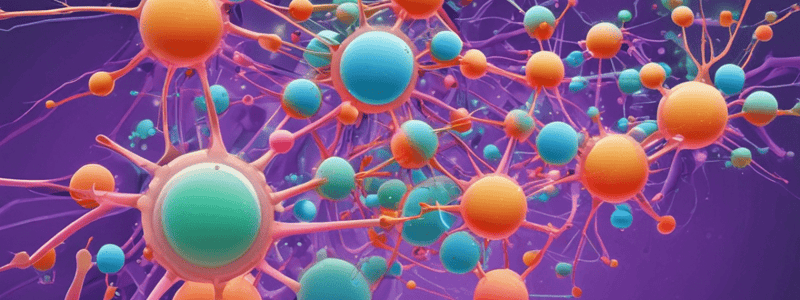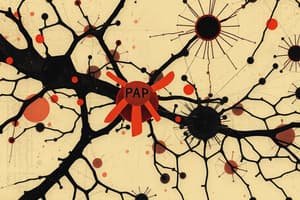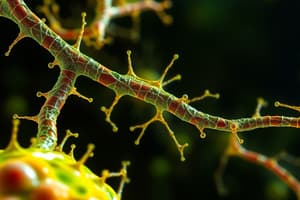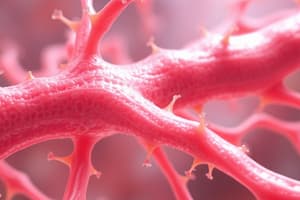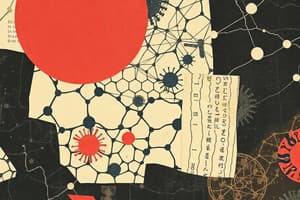Podcast
Questions and Answers
What is the primary function of cell adhesion molecules (CAMs)?
What is the primary function of cell adhesion molecules (CAMs)?
What type of ions do selectins, integrins, and most cadherins require for their function?
What type of ions do selectins, integrins, and most cadherins require for their function?
Which of the following is a characteristic of classic cadherins?
Which of the following is a characteristic of classic cadherins?
What is the name of the protein that binds to the cytosolic tail of cadherins?
What is the name of the protein that binds to the cytosolic tail of cadherins?
Signup and view all the answers
What is the term used to describe the ability of cadherins to form a superfamily with over 180 members?
What is the term used to describe the ability of cadherins to form a superfamily with over 180 members?
Signup and view all the answers
What is the role of trypsin in cell culture?
What is the role of trypsin in cell culture?
Signup and view all the answers
What is the term used to describe the binding of cadherins to actin filaments?
What is the term used to describe the binding of cadherins to actin filaments?
Signup and view all the answers
What is the term used to describe the process of cell adhesion in the formation of morula?
What is the term used to describe the process of cell adhesion in the formation of morula?
Signup and view all the answers
What is the main function of anchoring junctions?
What is the main function of anchoring junctions?
Signup and view all the answers
What is the role of integrins in cell-matrix adhesion?
What is the role of integrins in cell-matrix adhesion?
Signup and view all the answers
What type of junctions allow for the direct exchange of molecules between cells?
What type of junctions allow for the direct exchange of molecules between cells?
Signup and view all the answers
What is the primary function of occluding junctions?
What is the primary function of occluding junctions?
Signup and view all the answers
What is the primary component of the basal laminae?
What is the primary component of the basal laminae?
Signup and view all the answers
What is the primary function of signal junctions?
What is the primary function of signal junctions?
Signup and view all the answers
What type of junctions are involved in cell-cell adhesion?
What type of junctions are involved in cell-cell adhesion?
Signup and view all the answers
What is the primary role of the ECM in cell-matrix adhesion?
What is the primary role of the ECM in cell-matrix adhesion?
Signup and view all the answers
What is the main function of polysaccharides in the ECM?
What is the main function of polysaccharides in the ECM?
Signup and view all the answers
What type of proteins link matrix components to one another and to the surfaces of cells?
What type of proteins link matrix components to one another and to the surfaces of cells?
Signup and view all the answers
What is the function of fibronectin in the ECM?
What is the function of fibronectin in the ECM?
Signup and view all the answers
What is the main component of basal laminae?
What is the main component of basal laminae?
Signup and view all the answers
What is the function of laminins in the ECM?
What is the function of laminins in the ECM?
Signup and view all the answers
What protein is tightly associated with laminins in the ECM?
What protein is tightly associated with laminins in the ECM?
Signup and view all the answers
What is the function of nidogen in the ECM?
What is the function of nidogen in the ECM?
Signup and view all the answers
What is the shape of the laminin heterotrimers in the ECM?
What is the shape of the laminin heterotrimers in the ECM?
Signup and view all the answers
What is the term for the process of generating the shape of a cell, tissue, or organ?
What is the term for the process of generating the shape of a cell, tissue, or organ?
Signup and view all the answers
What is the composition of a tissue?
What is the composition of a tissue?
Signup and view all the answers
How many major types of tissues are there?
How many major types of tissues are there?
Signup and view all the answers
What is built from tissues?
What is built from tissues?
Signup and view all the answers
What type of tissue is characterized by polarity arrangements?
What type of tissue is characterized by polarity arrangements?
Signup and view all the answers
What is responsible for generating tissue structures and shapes?
What is responsible for generating tissue structures and shapes?
Signup and view all the answers
What is the characteristic of epithelial cells in tissues?
What is the characteristic of epithelial cells in tissues?
Signup and view all the answers
What is the example of a connective tissue shown in the text?
What is the example of a connective tissue shown in the text?
Signup and view all the answers
What is the main function of tight junctions in epithelial cells?
What is the main function of tight junctions in epithelial cells?
Signup and view all the answers
What is the relationship between tight junctions and adherens junctions?
What is the relationship between tight junctions and adherens junctions?
Signup and view all the answers
What type of molecules can pass through gap junctions?
What type of molecules can pass through gap junctions?
Signup and view all the answers
What is the primary function of gap junctions?
What is the primary function of gap junctions?
Signup and view all the answers
Where are gap junctions typically found?
Where are gap junctions typically found?
Signup and view all the answers
What is the significance of tight junctions in the blood-brain barrier?
What is the significance of tight junctions in the blood-brain barrier?
Signup and view all the answers
What is the relationship between tight junctions and cell polarity?
What is the relationship between tight junctions and cell polarity?
Signup and view all the answers
What is the primary difference between tight junctions and gap junctions?
What is the primary difference between tight junctions and gap junctions?
Signup and view all the answers
What is the process by which a stem cell changes into a specialised cell?
What is the process by which a stem cell changes into a specialised cell?
Signup and view all the answers
What is the term for the process of generating the shape of a cell, tissue, or organ?
What is the term for the process of generating the shape of a cell, tissue, or organ?
Signup and view all the answers
What type of cells have polarity arrangements?
What type of cells have polarity arrangements?
Signup and view all the answers
What is the main function of the extracellular matrix in cell-matrix adhesion?
What is the main function of the extracellular matrix in cell-matrix adhesion?
Signup and view all the answers
What is the term for the process of cells becoming committed to different pathways of development?
What is the term for the process of cells becoming committed to different pathways of development?
Signup and view all the answers
What is the primary function of tight junctions in epithelial cells?
What is the primary function of tight junctions in epithelial cells?
Signup and view all the answers
What is a characteristic of somatic stem cells?
What is a characteristic of somatic stem cells?
Signup and view all the answers
During embryogenesis, how many germ layers are formed?
During embryogenesis, how many germ layers are formed?
Signup and view all the answers
What is a characteristic of unipotent somatic stem cells?
What is a characteristic of unipotent somatic stem cells?
Signup and view all the answers
What is the significance of the three germ layers formed during embryogenesis?
What is the significance of the three germ layers formed during embryogenesis?
Signup and view all the answers
What is the role of somatic stem cells in the body?
What is the role of somatic stem cells in the body?
Signup and view all the answers
What is a characteristic of multipotent somatic stem cells?
What is a characteristic of multipotent somatic stem cells?
Signup and view all the answers
What is the primary mechanism by which stem cell fate is controlled?
What is the primary mechanism by which stem cell fate is controlled?
Signup and view all the answers
What is the outcome of cell differentiation?
What is the outcome of cell differentiation?
Signup and view all the answers
What is epigenetics dependent on?
What is epigenetics dependent on?
Signup and view all the answers
What type of signals can influence cell fate?
What type of signals can influence cell fate?
Signup and view all the answers
What is the role of DNA methylation in gene activity?
What is the role of DNA methylation in gene activity?
Signup and view all the answers
What is the significance of chromatin modification in gene activity?
What is the significance of chromatin modification in gene activity?
Signup and view all the answers
What is the outcome of cell determination?
What is the outcome of cell determination?
Signup and view all the answers
What is the relationship between gene expression and cell differentiation?
What is the relationship between gene expression and cell differentiation?
Signup and view all the answers
Study Notes
Cell-Cell Adhesion
- Cell-cell adhesion is selective, meaning cells only adhere to specific types.
- It is mediated by transmembrane adhesion proteins known as cell adhesion molecules (CAMs).
- CAMs span the cell membrane, with one end linking to the cytoskeleton and the other end linking to structures outside it.
- There are four groups of CAMs: cadherins, selectins, integrins, and immunoglobulin (Ig superfamily).
Cell-Cell Adhesion - Anchoring Junctions
- Anchoring junctions are a type of cell-cell adhesion that provides strength and shape to cells.
- Cadherins, integrins, and selectins are examples of anchoring junctions.
- These junctions require Ca2+, Mg2+, or Mn2+ to function.
Cell-Cell Adhesion - Cadherins
- Cadherins are a type of anchoring junction that plays a crucial role in cell polarity.
- They are highly selective, allowing for the formation of many different tissues.
- There are many different types of cadherins, forming a superfamily of 180 members.
- Cadherins require Ca2+ to function, hence they are also known as "calcium adhering".
- They bind directly or indirectly to adapter proteins that bind to actin filaments.
Cell-Cell Adhesion - Tight Junctions
- Tight junctions are specialized contacts between epithelial cells that are important for epithelial cell sheet function.
- They act as barriers between fluid compartments, such as the blood-brain barrier.
- Tight junctions have minimal adhesive strength, so they associate with adherens junctions and desmosomes.
Cell-Cell Adhesion - Gap Junctions
- Gap junctions are channels that allow direct communication between the cytoplasm of adjacent cells.
- They are regulated channels that allow the passage of ions and small molecules.
- Gap junctions are important for cell-to-cell communication and coordination.
Cell-Matrix Adhesion Proteins - Integrins
- Integrins are transmembrane receptors that mediate the linkage between the extracellular matrix and the cytoskeleton.
- They allow the external cellular environment to influence intracellular functions.
- Integrins are important for cell-matrix adhesion and signaling.
Cell-Matrix Adhesion Proteins - Fibronectin
- Fibronectin is a matrix adhesion protein that links matrix components to one another and to the surfaces of cells.
- It is a dimeric glycoprotein that is cross-linked into fibrils in the ECM.
- Fibronectin has binding sites for collagen and GAGs, and is a major binding site for cell surface receptors, such as integrins.
Cell-Matrix Adhesion Proteins - Laminins and Nidogen
- Laminins are principal components of and major organizers of basal laminae.
- They can self-assemble into mesh-like networks and have binding sites for cell surface receptors and other ECM components.
- Nidogen is tightly associated with laminins and binds to type IV collagen.
Tissue Types
- Tissue is composed of cells and extracellular matrix.
- The four main types of tissues are: connective, nervous, muscle, and epithelial.
- Tissue structures and shapes can be formed by the organization of groups of cells into polarized arrangements and by coordinating their polarity in space and time.
Tissue Types - Connective Tissue
- Connective tissue is a type of tissue that provides support, structure, and connectivity to the body.
- It is composed of cells and ECM, with a high percentage of ECM.
- Examples of connective tissue include loose connective tissue, dense irregular connective tissue, and dense regular connective tissue.
ECM Polysaccharides
- The ECM is composed of fibrous collagen and elastin structural proteins, which are embedded in gels formed from polysaccharides.
- Glycosaminoglycans (GAGs) are highly negatively charged and attract lots of cations, which in turn attract water, forming a porous, hydrated gel.
- The gel provides mechanical support to the ECM.
Cell Plasticity and Differentiation
- Totipotent cells can give rise to a complete organism
- Pluripotent cells can give rise to all cell types in an organism
- Multipotent cells can give rise to multiple cell types within a specific tissue or organ
- Unipotent cells can give rise to only one cell type
Cell Differentiation and Determination
- Cellular differentiation is the process by which a stem cell changes into a specialized cell, losing its precursor properties and acquiring new characteristics
- Involves a change in gene expression
- Cell type is characterized by the cell’s protein expression profile
- Cellular determination is the process by which initially identical cells become committed to different pathways of development
- Determination is an irreversible process
Stem Cell Fate
- Stem cell fate is controlled by asymmetric cell division, where determinants are segregated during cell division, resulting in daughter cells with different fates
- Stem cell fate is also influenced by extrinsic (external) signals, such as those from the cell niche, and intrinsic (internal) signals, such as changes in DNA methylation or chromatin modification
Embryogenesis
- During gastrulation, three germ layers are formed: ectoderm, endoderm, and mesoderm
- These germ layers can differentiate into all adult cells in the body
Types of Stem Cells
- Somatic stem cells are found in tissues and organs of the juvenile and adult body
- Somatic stem cells are multipotent or unipotent, and maintain homeostasis and regenerate local tissue
- Unipotent somatic stem cells can give rise to a single mature cell type
- Progenitor cells are less plastic and more differentiated, giving rise to multiple but limited number of lineages, usually a restricted/related group of cells
Factors Affecting Stem Cell Fate
- Inductive signals, such as those from the cell niche, can influence stem cell fate
- Extrinsic signals, such as those from the environment, can also influence stem cell fate
- Intrinsic signals, such as changes in DNA methylation or chromatin modification, can also affect stem cell fate
Studying That Suits You
Use AI to generate personalized quizzes and flashcards to suit your learning preferences.
Related Documents
Description
This quiz covers the selective process of cell-cell adhesion, mediated by transmembrane adhesion proteins known as cell adhesion molecules (CAMs). Learn about the different groups of CAMs and their functions.
